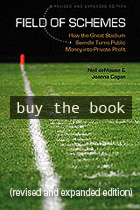This is an archived version of a Field of Schemes article. Comments on this page are closed. To find the current version of the article with updated comments, click here.
April 26, 2010
Rays stadium financing: Could the team turn a profit?
The Tampa Tribune had a long piece yesterday running down everything that's wrong with the Rays' Tropicana Field, including that the skyboxes have obstructed views of the roof and that the food concessionnaire is crappy. (This may be the first-ever suggestion that a team should build a new stadium just to get out of a concessions contract. Tim Naehring and the chef's salad controversy notwithstanding.) But the more interesting tidbit is one that's almost brushed over in the article:
Without the amenities and attractions found at modern ballparks, the Tampa Bay Rays are missing out on a potential $40 million in additional revenue, experts said.
If true, that would be a hugely significant statement: Since the annual cost of paying off a new stadium has been estimated at around $30 million, that would mean the Rays could actually pay for a new stadium themselves without any public money at all. Yes, it would be a lot of work to go through just to get a net profit amounting to less than it would cost just to re-sign Carl Crawford, but a profit is a profit — and asking the public for $10 million or so is likely to be much more attainable than an entire $30 million.
The question, then, is: Is it true? The Trib never says which "experts" supplied that $40 million a year number, but let's look at the numbers to see if they make sense. According to Forbes, the Rays brought in about $156 million in revenue last year (and, not incidentally, turned and estimated $15.7 million profit). To add $40 million a year would essentially mean turning them into the St. Louis Cardinals ($195 million in revenue). If anyone reading this thinks that Tampa Bay has the same market potential as baseball-mad St. Louis — which, let's not forget, is currently in the honeymoon of its own new stadium — I've got a bridge to sell you.
Now, there's one important caveat on the Forbes figures: They're after revenue sharing, which the Cardinals pay into, and the Rays currently draw from. Normally, increasing revenues by $40 million would mean you'd lose about a third to revenue-sharing "taxes." (Depending on where you fell in the revenue spectrum; the formula is mind-numbingly complex.) Thanks to the Yankees loophole, however, the Cardinals can deduct their $16 million annual cost of their stadium bonds before paying revenue sharing. Some quick algebra (okay, not so quick — it's been a long time since 9th grade) shows that the Cardinals are likely bringing in around $50 million more than the Rays in order to end up with $40 million more net.
So let's be conservative and say that bringing in an extra $40 million a year in gross revenue would be the equivalent of just reaching the next revenue rung down from the Cardinals — say, the one occupied by the Washington Nationals ($184 million), Colorado Rockies ($183 million), or Texas Rangers( $180 million). Is that feasible? Maybe — Tampa Bay is a smaller media market than D.C. or Dallas, but larger than Denver. Though it also has 13% unemployment, which isn't really a great sign for prospective fan spending.
To sum up: If everything broke right, a new Rays stadium might bring in enough money for the team to turn a profit on it, barely. The only way for the Rays to get a windfall, then, would be to have the public pay for it — and even then (since they'd lose their stadium deduction), about a third of the new revenue would get siphoned off by MLB revenue sharing. So taxpayers are effectively being asked to foot the bill for $30 million in annual stadium subsidies, so that the Rays can get maybe $20-30 million more a year in net revenues.
In even simpler words: The Rays wouldn't make money on the stadium. They'd make money on the subsidy. And that, in a nutshell, is what's driving the new-stadium game: not obsolete stadiums, but the desire for public cash.
I really like how you used the whole "$40M in additional annual revenue" against the boosterism.
Posted by floormaster squeeze on April 26, 2010 02:55 PMThe bottom line is that the Rays feel it is easier to tap the public trough for the additional profits they would like than the much more difficult and prosaic task of actually marketing the team and selling tickets.
Posted by Ed on April 27, 2010 09:59 PMA real simple question: why should the public be paying for Major League Baseball? I don't understand that. Shouldn't professional baseball fans pay for professional baseball entertainment? The rays want the public to provide a $30 MM stadium subsidy and they will get maybe an extra $20-30 MM "net revenue" per year.
Doesn't that mean the rays just want a public gift. Wouldn't it be cheaper for the public to just give them $20 MM per year rather than spend $30 mm on a stadium and hope the rays get the $20-30 mm? Of course, if we give them $20 mm, they'll want another $20mm and another and another and another. The national pastime has turned into the national shakedown.





